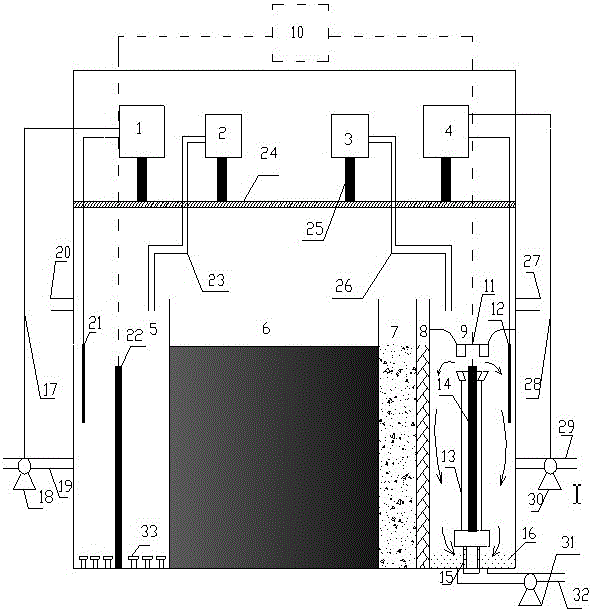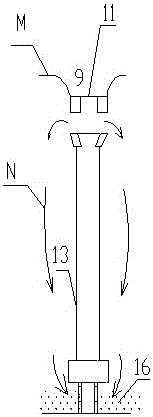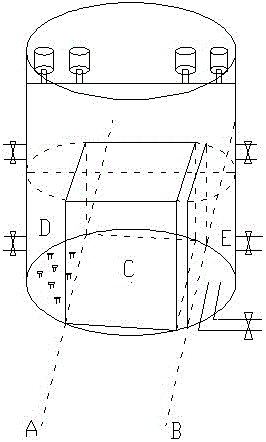Device for electro-kinetic remediation of heavy metal contaminated soil by utilizing copper salt reinforced cathode
A technology of polluted soil and electric remediation, applied in the restoration of polluted soil and other directions, can solve the problems of heavy metal deposition, blockage, reduction of remediation efficiency, pH mutation, etc., to reduce experimental errors and achieve the effect of automation
- Summary
- Abstract
- Description
- Claims
- Application Information
AI Technical Summary
Problems solved by technology
Method used
Image
Examples
Embodiment 1
[0033] The utility model relates to a device for electrodynamically repairing heavy metal polluted soil with a copper salt reinforced cathode. Both the cathode 1 and the anode 2 are electrodes made of graphite plates, and are respectively connected to the negative pole and the positive pole of a power supply 8 . The volume ratio of the cathode and anode chambers to the soil chamber is 1:3. The soil samples were collected from polluted soil in a certain place, and the concentrations of lead, cadmium, and zinc were 172, 13, and 650 mg / kg, respectively. The voltage was 30 V, the anolyte was citric acid-sodium citrate buffer solution with pH=3, and the cathode was 1 mol / L CuCl 2 Conductive solution, the experiment period is 400 h, and the heavy metals in the repaired soil samples are determined by flame atomic absorption method. After restoration, the removal rates of Pb, Cd and Zn were 72.8%, 70.6% and 70.2%, respectively.
Embodiment 2
[0035] The utility model relates to a device for electrodynamically repairing heavy metal polluted soil with a copper salt reinforced cathode. Both the cathode 1 and the anode 2 are electrodes made of graphite plates, and are respectively connected to the negative pole and the positive pole of a power supply 8 . The volume ratio of the cathode and anode chambers to the soil chamber is 1:1:3. The soil samples were collected from polluted soil in a certain place, and the concentrations of lead, cadmium, and zinc were 172, 13, and 650 mg / kg, respectively. The voltage is 30 V, the anolyte is citric acid-sodium citrate buffer solution with pH=3, and the cathode is 3 mol / L CuCl 2 Conductive solution, the experiment period is 400 h, and the heavy metals in the repaired soil samples are determined by flame atomic absorption method. After restoration, the removal rates of Pb, Cd and Zn were 75.1%, 73.6%, and 72.8%, respectively.
Embodiment 3
[0037] The utility model relates to a device for electrodynamically repairing heavy metal polluted soil with a copper salt reinforced cathode. Both the cathode 1 and the anode 2 are electrodes made of graphite plates, and are respectively connected to the negative pole and the positive pole of a power supply 8 . The volume ratio of the cathode and anode chambers to the soil chamber is 1:1:3. The soil samples were collected from polluted soil in a certain place, and the concentrations of lead, cadmium, and zinc were 172, 13, and 650 mg / kg, respectively. The voltage was 30 V, the anolyte was citric acid-sodium citrate buffer solution with pH=3, and the cathode was 5 mol / L CuCl 2 Conductive solution, the experiment period is 400 h, and the heavy metals in the repaired soil samples are determined by flame atomic absorption method. After restoration, the removal rates of Pb, Cd and Zn were 78.6 %, 75.3 % and 74.8 %, respectively.
PUM
 Login to View More
Login to View More Abstract
Description
Claims
Application Information
 Login to View More
Login to View More - R&D
- Intellectual Property
- Life Sciences
- Materials
- Tech Scout
- Unparalleled Data Quality
- Higher Quality Content
- 60% Fewer Hallucinations
Browse by: Latest US Patents, China's latest patents, Technical Efficacy Thesaurus, Application Domain, Technology Topic, Popular Technical Reports.
© 2025 PatSnap. All rights reserved.Legal|Privacy policy|Modern Slavery Act Transparency Statement|Sitemap|About US| Contact US: help@patsnap.com



